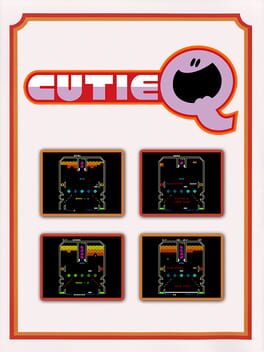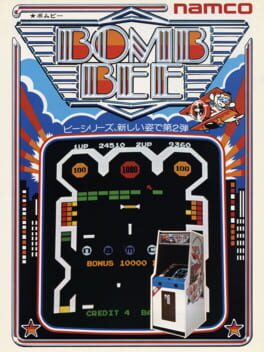

Cutie Q is is the third and final game in the Gee Bee trilogy. The player controls a set of paddles with a rotary knob, the objective being to score as many points possible by deflecting a ball against blocks, ghosts, spinners and other objects on the playfield. Cutie Q is described as Namco's first "character game", thanks to its use of colorful and cute character designs, a choice that would be a major influence on Toru Iwatani's next project, Pac-Man.
Also in series
Reviews View More
It's 2023, and Cutie Q has managed to set up shop in my head, rent-free and fully welcome.
Forget about the historical trappings; you can go read Wikipedia if you want to know why this game was important to Namco and Iwatani. I'm here to talk about the gameplay, Breakout inside a pinball shell, third time's the charm. The goals are simple, the scoring easy to figure out. The sounds have that indescribable charm, synthetic and raw. No jingles, no flashing lights, just a reasonably fair game about bouncing a ball.
First: the usual Breakout problems are solved. The constrained playfield, supplied angles and the nature of the ball's physics make it so that you're never chasing some interminable final block or losing all control of the situation. The scoring is restrained, but with just enough boundaries to break both per-ball and per-game. Those cute little ghosts? They go up in value each time you clear them, and that value doesn't reset between balls, giving you a very real incentive to aim for them. Meanwhile, the bonus seems modest, but the very moment you trip it over to 2x the stakes ratchet up and your goals shift to racking up as many increments as possible on it.
And the field itself? Simple, like I said, but perfectly so. The shifting of the ghosts' "jail" when the bottom paddle is used keeps the field dynamic, tempting you to go for more difficult configurations both for straight score and to make clearing the blocks easier. The top paddle cycles the EXTRA letters. The bottom, again, resets blocks as needed. The lower half is critical for getting the score multiplier, the upper for actually scoring points to make use of it. It's all simple risk and reward, with there being no best portion of the field and no singular strategy for easily racking up points, but it works so well.
So: spend some time with Cutie Q. Break your high score a few times. Get 100k, 300k. Feel the tension as you try to keep the ball alive to wring every last point out of a multiplier, become laser-focused on the ghosts after a lucky early streak raises their value absurdly high. Catch yourself thinking about playing a few rounds over your morning coffee, like I have been. It deserves to be more than a footnote.
Forget about the historical trappings; you can go read Wikipedia if you want to know why this game was important to Namco and Iwatani. I'm here to talk about the gameplay, Breakout inside a pinball shell, third time's the charm. The goals are simple, the scoring easy to figure out. The sounds have that indescribable charm, synthetic and raw. No jingles, no flashing lights, just a reasonably fair game about bouncing a ball.
First: the usual Breakout problems are solved. The constrained playfield, supplied angles and the nature of the ball's physics make it so that you're never chasing some interminable final block or losing all control of the situation. The scoring is restrained, but with just enough boundaries to break both per-ball and per-game. Those cute little ghosts? They go up in value each time you clear them, and that value doesn't reset between balls, giving you a very real incentive to aim for them. Meanwhile, the bonus seems modest, but the very moment you trip it over to 2x the stakes ratchet up and your goals shift to racking up as many increments as possible on it.
And the field itself? Simple, like I said, but perfectly so. The shifting of the ghosts' "jail" when the bottom paddle is used keeps the field dynamic, tempting you to go for more difficult configurations both for straight score and to make clearing the blocks easier. The top paddle cycles the EXTRA letters. The bottom, again, resets blocks as needed. The lower half is critical for getting the score multiplier, the upper for actually scoring points to make use of it. It's all simple risk and reward, with there being no best portion of the field and no singular strategy for easily racking up points, but it works so well.
So: spend some time with Cutie Q. Break your high score a few times. Get 100k, 300k. Feel the tension as you try to keep the ball alive to wring every last point out of a multiplier, become laser-focused on the ghosts after a lucky early streak raises their value absurdly high. Catch yourself thinking about playing a few rounds over your morning coffee, like I have been. It deserves to be more than a footnote.
Despite being Namco's third iteration on the Breakout/Pinball hybrid, Cutie Q felt like the game I had the least enjoyable time with. In Bee Gee and Bomb Bee, I appreciated the ways that they were attempting to blend pinball elements like bumpers and flippers into the game. With Cutie Q, those kinetic elements are replaces with little blobs, and smiley faces that don't provide much feedback upon hitting.
I'm honestly a bit disappointed because I think Bomb Bee was so close to being a mix that felt good. So I would have loved to have seen more iteration with the pinball style.
That being said, it's cool that this game's mascot design and little ghosts were an artistic push that would lead to the design of pac-man and I'm all for making your game a bit cartoony. However the loss of virtual haptics alongside the game overall being a bit more sluggish only makes the cartoon direction feel hollow.
Maybe there will be a fourth Gee Bee game some day...?
I'm honestly a bit disappointed because I think Bomb Bee was so close to being a mix that felt good. So I would have loved to have seen more iteration with the pinball style.
That being said, it's cool that this game's mascot design and little ghosts were an artistic push that would lead to the design of pac-man and I'm all for making your game a bit cartoony. However the loss of virtual haptics alongside the game overall being a bit more sluggish only makes the cartoon direction feel hollow.
Maybe there will be a fourth Gee Bee game some day...?
Really enjoyed this one, mainly because it substracted a lot of the Breakout elements of the previous title and went on with a lot of variations that resembled a Pinball machine more than ever. In the end, it kind of turned into the best of both worlds, as it offered tons of shiny extras and a clear objective at the same time.
------------------------------------------------------------------------------------------
Me lo pasé muy bien con esto, principalmente porque quitó muchos de los elementos Breakout del título anterior y añadió cosas que hacían que se pareciera más a una máquina de pinball. Al final, el título presenta lo mejor de ambos mundos, ya que ofrece muchos extras atrayentes al tiempo que un objetivo claro.
------------------------------------------------------------------------------------------
Me lo pasé muy bien con esto, principalmente porque quitó muchos de los elementos Breakout del título anterior y añadió cosas que hacían que se pareciera más a una máquina de pinball. Al final, el título presenta lo mejor de ambos mundos, ya que ofrece muchos extras atrayentes al tiempo que un objetivo claro.


